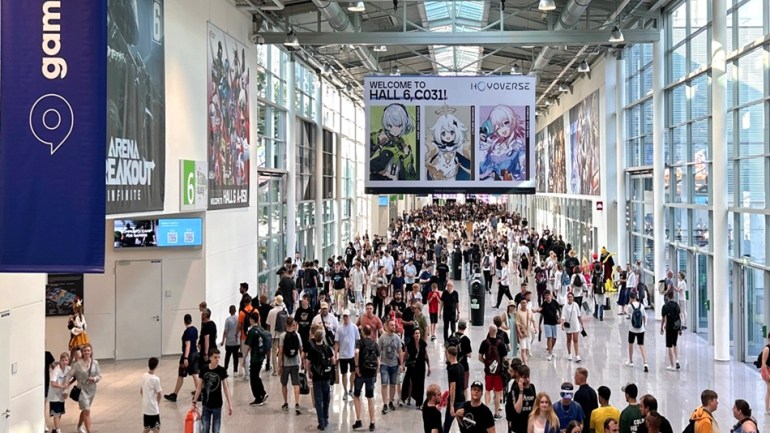
Being able to attend Gamescom 2025 in Cologne on a leisurely, hustle-free basis is one of the perks of living in Belgium, aside from enjoying the best French fries (which are originally Belgian) along with quality mayonnaise and chocolate pralines all year long!
While Gamescom 2025 was my second time visiting this popular annual gaming event (RIP E3) it came with both joy and fear — joy from playing some of the boldest upcoming titles, and fear from realizing a rising and costly trend in the industry.
Let’s start with the good and go through the three boldest Gamescom 2025 demos that I played.
***
Pragmata

It’s always nice to see big names trying new ideas, especially when it’s Capcom. Though the idea behind Pragmata looks like another take on the humans vs rogue AI trope, the way Capcom added a cute little girl as the companion AI to support the player enriched the experience emotionally. Gameplay, on the other hand, is bold. Players have to hack enemies (in a tech sense) and shoot them at the same time while avoiding being hit. Though both the hacking and gunplay mechanics are pretty straightforward, doing them together is the exciting challenge that’s unique to Pragmata. There are also platforming aspects as the protagonists hover around the environment and over pits and traps with a jetpack, but the demo was too short to focus much on this aspect. For those who are tired of every action game being another soulslike, roguelike, Overwatch clone or remake, Pragmata is a breath of fresh air.
***
Onimusha: The Way of the Sword

I love fantasy action games — perhaps it’s due to growing up in the early 2000s, when there were loads of them. The PlayStation 2 was full of great entries in the genre, Onimusha was one of them. The series started as a hack & slash based on Capcom’s technical achievements made with the Resident Evil series, but soon found its own footing. After a long hiatus that lasting two decades, a new Onimusha is coming next year, and boy, it’s good to have it back! What immediately caught my eye with Way of the Sword’s demo was how the game retained its unique essence. While the basic swordplay was what one might expect, Way of the Sword creates a cycle that players needed to actively follow during combat. Enemies take damage and have their postures broken before they can be executed, but if players keep button-mashing, they’ll lose the execution window. The swordplay also feels weighty and authentically recreated with the goal of making every stroke of the blade feel painful and real. To anyone who is an old-time fan of the series or any Sekiro: Shadows Die Twice fans that are tired of waiting for the sequel, Onimusha the Way of the Sword is a sight for sore eyes.
***
Crimson Desert

Pearl Abyss’s Crimson Desert is a promising Korean title, and perhaps the most ambitious one on my list. Set in the world of the popular Black Desert Online, Pearl Abyss’ upcoming third-person action-adventure is one of the most mechanically complicated titles in the genre that I’ve seen, seemingly a blend of other wildly successful action-adventure franchises. There are levitated sky islands that can be reached and explored like The Legend of Zelda: Tears of the Kingdom. The climbing and parkour mechanics are inspired by the Middle-Earth: Shadow series, and the combat is something like the new era of Assassin’s Creed titles. There are just so many mechanics! The list includes (but is not limited to) gliding, riding a horse, climbing, picking up and dropping objects, light and heavy sword attacks, blocking and parrying, using magic and ultimate abilities, dodging and vaulting over enemies, and using environmental attacks and weapons, and more. In the demo, it was truly difficult to learn them all. In my experience, titles with such a huge swath of mechanics end up being shallow and incoherent. Yet there have been studios that defy the odds and make history. Hopefully, Pearl Abyss’ ambitious Crimson Desert is one of them.
***
Profit & Problems
So that was the good. Now, to the not-so-good.
What caught my attention in this regard at 2025 Gamescom were the number of reappearances. A lot of titles, even smaller indies like Reanimal and Little Nightmares 3, returned to Gamescom this year. While at first that didn’t seem like anything special, when digging a bit deeper I felt like this is signaling an issue plaguing the industry — long development times.
The longer it takes for a product to be made, the more time and energy the workforce behind it is supposed to invest. Consequently, the costs of production increase as companies have to pay the workforce for their time. Long development times used to be an issue mainly experienced by AAA game devs, but 2025 Gamescom was, a turning point, in my opinion, as many studios seem to be wrestling with this challenge.
Of course, we love videogames as a medium that enables us to interact with artists’ visions, but the fact is that videogames are also part of the entertainment industry — and actually, its most lucrative branch. For any industry to survive, it needs to be sustainable. As such, extended development times create an unsustainable environment in which many games might eventually cost so much and take so long that by the time the game is published there’s little chance of recouping costs and making profit in such a competition-heavy, fast-moving medium. Without change, I fear the current situation can only lead to a crash akin to the dot-com bubble in the early 2000s.
We’ve already seen how big industry names are jumping on the “$80 pricepoint” train while others are downsizing or replacing workforce with AI, which comes with its own wealth of issues. Of course, there are ways to decrease the development costs and time, but that doesn’t mean it’ll be painless, and we might have to start thinking about new norms and new expectations.
There’s no easy way out of this situation, and the elephant in the Gamescom hall is becoming more and more difficult to avoid. If nothing changes, players will pay increased prices while waiting half a decade for our favorite games to hit shelves. I don’t think that’s attractive to anyone, and it certainly doesn’t seem sustainable.
At the end of the day, both producers and consumers will likely need to buckle up and work together to find a new way to improve things for all sides.
The post OPINION: The Good & Bad – Gamescom 2025 appeared first on Gamecritics.com.




This post offers an interesting perspective on Gamescom 2025! It’s great to hear about the benefits of attending in a more relaxed environment. Looking forward to seeing how the event unfolds!
I completely agree! Attending Gamescom without the usual rush sounds like a fantastic experience. Plus, having the chance to engage more deeply with the games and developers could lead to some really meaningful conversations.
Absolutely! A more leisurely pace would really allow attendees to soak in all the details and innovations. Plus, it could lead to more meaningful interactions with developers and other fans.